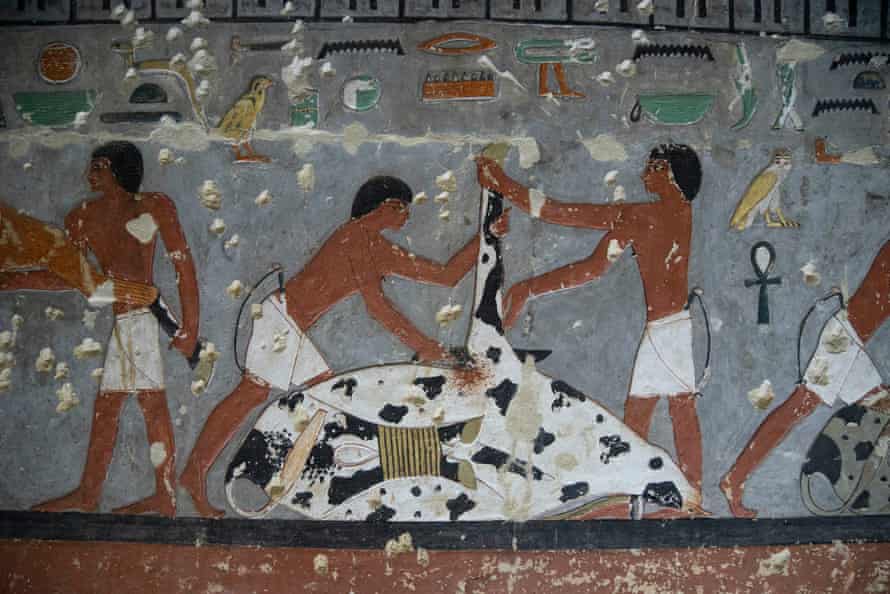Mummy's older than we thought: new find could rewrite history
Discovery of nobleman Khuwy shows that Egyptians were using advanced embalming methods 1,000 years before assumed date

The ancient Egyptians were carrying out sophisticated mummifications of their dead 1,000 years earlier than previously thought, according to new evidence which could lead to a rewriting of the history books.
The preserved body of a high-ranking nobleman called Khuwy, discovered in 2019, has been found to be far older than assumed and is, in fact, one of the oldest Egyptian mummies ever discovered. It has been dated to the Old Kingdom, proving that mummification techniques some 4,000 years ago were highly advanced.
The sophistication of the body's mummification process and the materials used – including its exceptionally fine linen dressing and high-quality resin – was not thought to have been achieved until 1,000 years later.
Professor Salima Ikram, head of Egyptology at the American University in Cairo and a leading expert on the history of mummification, told the Observer: "If this is indeed an Old Kingdom mummy, all books about mummification and the history of the Old Kingdom will need to be revised."
She added: "This would completely turn our understanding of the evolution of mummification on its head. The materials used, their origins, and the trade routes associated with them will dramatically impact our understanding of Old Kingdom Egypt.
"Until now, we had thought that Old Kingdom mummification was relatively simple, with basic desiccation – not always successful – no removal of the brain, and only occasional removal of the internal organs. Indeed, more attention was paid to the exterior appearance of the deceased than the interior. Also, the use of resins is far more limited in the Old Kingdom mummies thus far recorded. This mummy is awash with resins and textiles and gives a completely different impression of mummification. In fact, it is more like mummies found 1,000 years later."
It is among major discoveries to be revealed in National Geographic's documentary series, Lost Treasures of Egypt, starting on 7 November. It is produced by Windfall Films, and the cameras follow international archaeologists during the excavation season in Egypt. The mummification discovery will feature in episode four – entitled Rise of the Mummies – on 28 November.
 4240
4240Ikram appears in that episode with fellow archaeologist Dr Mohamed Megahed, who says of the latest discovery: "If it's really Khuwy, this is a breakthrough in Ancient Egyptian history."
The mummy's discovery in a lavish tomb in the necropolis at Saqqara was filmed in National Geographic's earlier season. The investigation into its dating and analysis emerges in the new series. Hieroglyphs revealed that it belonged to Khuwy, a relation of the royal family who lived over 4,000 years ago.
Tom Cook, the series producer for Windfall Films, said: "They knew the pottery in the tomb was Old Kingdom but [Ikram] didn't think that the mummy was from [that period] because it was preserved too well. They didn't think the mummification process [then] was that advanced. So her initial reaction was: this is definitely not Old Kingdom. But over the course of the investigation she started to come round [to the idea]."
Ancient embalmers bathed bodies in expensive resins from tree sap, preserving the flesh before they wrapped the corpse. This mummy is impregnated with high-quality resins and wrapped in the highest-grade of bandages.
Ikram says in the programme: "It's extraordinary. The only time I've [seen] so much of this kind of good quality linen has been in the 21st dynasty." The 21st dynasty of Egyptian Pharaohs reigned more than 1,000 years after Khuwy lived.
Carolyn Payne, National Geographic's commissioning editor, said that what makes this series so unusual is that it follows a whole group of different archaeologists across a season: "We did see some amazing finds."
The documentary observes: "With every new body archaeologists unearth, the story of the mummies of Egypt becomes clearer."
-- Sent from my Linux system.
No comments:
Post a Comment